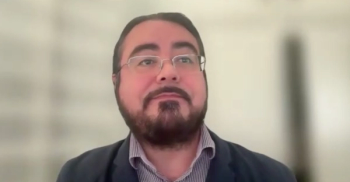
Linvoseltamab Approval Offers New Off-the-Shelf Option for Heavily Pretreated Multiple Myeloma: Hans Lee, MD
The newly approved linvoseltamab (Lynozyfic; Regeneron) has a manageable safety profile, along with a patient-friendly dosing schedule that includes intravenous administration, step-up dosing, and de-escalation to monthly maintenance.
On July 2, the FDA
This approval was
In an interview with The American Journal of Managed Care®, Hans Lee, MD, a LINKER-MM1 investigator and director of myeloma research at Sarah Cannon Research Institute, highlights the key findings of the trial, which he conducted during his time at MD Anderson Cancer Center. He also discusses how the approval may influence clinical decision-making for patients with heavily pretreated multiple myeloma.
This transcript was lightly edited; captions were auto-generated.
Transcript
Can you summarize the key findings of the LINKER-MM1 trial and how they supported the FDA's approval of linvolseltamab for patients with R/R multiple myeloma who have received at least 4 prior lines of therapy?
The LINKER-MM1 study was a phase 1/2 study that evaluated the drug linvoseltamab, which is a BCMA bispecific antibody for the treatment of relapsed/refractory multiple myeloma. Specifically, the trial enrolled [patients with] heavily pretreated myeloma with at least 3 prior lines of therapy who are triple-class exposed. This means patients were exposed to a proteasome inhibitor, an immunomodulatory drug, and an anti-CD38 monoclonal antibody, or were triple-class refractory, regardless of lines of prior therapy.
A total of 117 patients enrolled in the study who received a 200 mg FDA-approved dose of linvoseltamab, and the drug in the trial showed a very high overall response rate of 71%. Not only were the response rates very high, but the depth of response was also very impressive, with a complete response rate or better of 52%.
This also translated into durability response as well. At the last data cut of a median follow-up of approximately 21 months, the median progression-free survival had actually not been reached yet, and the median duration of response was approximately 29 months.
In terms of the safety profile of linvoseltamab, again, the most common side effect is cytokine release syndrome, or CRS. This is common with [chimeric antigen receptor T-cell] therapies and bispecific T-cell antibodies. Although the total incidence of CRS is relatively low—[a] 46% incidence of CRS, with the majority being grade 1, some grade 2, and very rarely grade 3.
I think the other sort of side effect to be mindful of is the infection risk. Infections are common in patients receiving BCMA bispecific antibodies, although the rates of infections actually decrease with time. After 6 months of treatment on linvoseltamab in the clinical trial with de-escalation [of] the frequency of dosing, the rates of infection of grade 3 or higher decreased to 5% to 8%.
What does this approval mean for patients with heavily pretreated multiple myeloma, and how do you see it shaping clinical decision-making going forward?
The approval of linvoseltamab is important because it really provides a very highly effective off-the-shelf therapy for the treatment of relapsed/refractory multiple myeloma. While there are several other BCMA bispecific antibodies currently approved by the FDA for patients in this population, I do think that linvoseltamab does have some differentiating characteristics, as well, that I think will be beneficial to patients.
First of all, it has a different administration route. It is intravenously given instead of subcutaneously given. I think this does impact the kinetics of the onset of cytokine release syndrome and the resolution. What this ultimately translates into is that there's fewer hospitalization requirements for the administration of linvolseltamab compared [with] the other BCMA bispecific antibodies.
Basically, there are hospitalization requirements for the first 2 doses. The first 2 step-up doses [are] dosed 1 week apart, but the hospitalization requirement is only 24 hours. Basically, a 24-hour hospitalization for dose number 1, step-up dose number 2, and all outpatient thereafter.
I think, secondly, what was very interesting about the LINKER-MM1 study was that there was a prospective de-escalation of the frequency of dosing built into the study. Patients receive weekly linvoseltamab for the first 3 cycles but then [are] de-escalated to every other week dosing for cycles 4 and 5 and then de-escalate even further to every 4-week dosing starting [with] cycle number 6 if a patient achieves a very good partial response or better.
Again, a very prospective, more patient-friendly dosing schedule to, ultimately, every 4-week dosing, which is much better for our patients.
Newsletter
Stay ahead of policy, cost, and value—subscribe to AJMC for expert insights at the intersection of clinical care and health economics.





























































